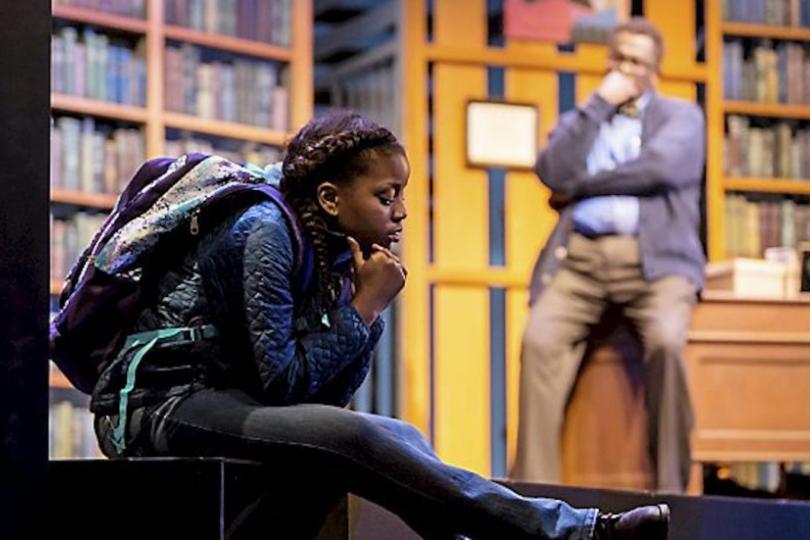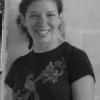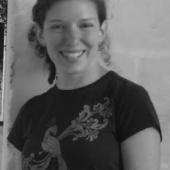Bee more

Both in and out of the theater world, conversations about racial inequalities bring out strong feelings. The local and national spotlight on these inequalities has grown exponentially over the past year, but the very necessary work to address systemic oppression is extremely challenging and highly charged. Amidst so many contentious issues, it is nice to see a show like Akeelah and the Bee, which unapologetically celebrates the power of children to bring communities together, and the power of a community to support its children.
But wait, you’re probably saying, isn’t this message a little simplistic, especially given the racial climate at the moment? Yes it is, and I’ll get there in a minute. For now, I want to focus on giving the Children’s Theatre all the credit it’s due for starting out its 50th season on the right foot.
First of all, playwright Cheryl L. West and director Charles Randolph-Wright have adapted a pretty cheesy 2006 movie (starring, most famously, Laurence Fishburne and Angela Bassett) into a legitimately heart-warming (and non-barfworthy) play about a girl from the South Side of Chicago who dreams of winning the National Spelling Bee. As Akeelah comes into her own power as a total spelling nerd, she brings out the good in the people around her. We root for her not because of the spelling bee itself, but because of the way her perseverance touches her community.
16-year-old Johannah Easley does a lot to bring the role of Akeelah to life. Akeelah is not just a precocious 11-year-old; she is wounded by a traumatic past and has taken on the immense burden of being the one in her family who will do “something of merit.” Easley not only transforms herself seamlessly into an awkward tween, she also conveys exactly how hard Akeelah has to fight for her own identity in a community more preoccupied with making ends meet than with the spelling of words like “Scheherazadian”.
Easley is also surrounded by an excellent cast that does all it can to bring the characters out of the realm of stereotype. Both the original movie and the stage adaptation resort to cliché for several supporting characters, the most problematic of which is the portrayal of an unyielding Asian father and his ultra-academic son. On the other hand, we get to see multiple facets to characters like Akeelah’s older brother Reggie (Nathan Barlow), whose loyalty to his sister is one of his few anchors in a long history of missteps and petty crime, and Akeelah’s mother Gail (Aimee K. Bryant), whose valiant efforts to hold her family together often leave her lacking the time and energy to connect with her daughter.
Alexander V. Nichols’s set design is also fantastic. Inspired by urban architecture, he uses four-sided rotating columns to allow row houses to transform into a posh professor’s office and a stiflingly wealthy back yard – almost as if the change of scene itself is what gradually teaches Akeelah to see different sides of herself and others.
Although the plot of the show ventures into the realm of the after-school special, I don’t think that’s necessarily a bad thing in this case. We need more opportunities to praise the communities that have been, and continue to be, built in poor neighborhoods, and among people of color. We need more reminders of how much talent and dedication exists, and may be overlooked, in crowded, under-funded districts. The theater community needs more roles that highlight the many amazing actors of color in the Twin Cities, and the educational community needs more ways to talk to kids about race, class, and privilege.
But while I think Akeelah is the type of show that we need more of, I also believe that it’s a show that we need more from. As mainstream discourse on race and structural inequality has gotten more nuanced, we should also consider making kids part of that discussion. The Children’s Theatre website (although not the program) lists discussion topics that all center on goal-setting, community support, motivation and personal power. These are excellent and valuable starting points, but I think that many children, even as young as 8 or 9, are able to start thinking more deeply about the world around them – particularly when a play like this one gives them such a good jumping-off point.
As a teacher myself, my mind goes instantly to the questions I would want to discuss with students after seeing Akeelah and the Bee. So I will leave you with some questions that I wished were in the program, in case you see the show with a tween who, with the help of the play’s strong acting and clear messaging, can take Akeelah a few steps further:
- What do you think will happen to the characters after they get home from the bee? What will change in their lives, and what won’t?
- Do you have friends outside your own neighborhood, ethnicity, or social class?
- If so, what are the best parts about having friends with different backgrounds than you? What are the biggest challenges?
- If not, why do you think this is? What gets in the way of meeting or making friends with people with different backgrounds than you?
- Akeelah, Javier, Dylan, and Trish are all smart and hard-working, but they come from very different places. What do the different characters see out their windows? How do you think their surroundings affect how they see themselves?
- Find out about your own neighborhood. What is its history, and why does your family live there? What kinds of jobs do the adults in your area have? What would your life be like if you lived somewhere else?
- Akeelah and the Bee shows that everyone benefits from working together, both inside a community and from one community to another. How can you work with your community? How can you meet and work together with people from other communities?




